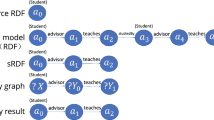Abstract
This paper focuses on the issue of OWL-DL ontology queries implemented in SPARQL. Currently, ontology repositories construct inference ontology models, and match SPARQL queries to the models, to derive inference results. Because an inference model uses much more storage space than the original model, and cannot be reused as inference requirements vary, this method is not suitable for large-scale deployment. To solve this problem, this paper proposes a novel method that passes rewritten SPARQL queries to the original ontology model, to retrieve inference results. We define OWL-DL inference rules and apply them to rewriting Graph Patterns in queries. The paper classifies the inference rules and discusses how these rules affect query rewriting. To illustrate the advantages of our proposal, we present a prototype system based on Jena, and address query optimization, to eliminate the disadvantages of augmented query sentences. We perform a set of query tests and compare the results with related works. The results show that the proposed method results in significantly improved query efficiency, without compromising completeness or soundness.
Similar content being viewed by others
References
ARQ—A SPARQL Processor for Jena. http://jena.sourceforge.net/ARQ/
Broekstra J, Kampman A (2003) Inferencing and truth maintenance in RDF schema: exploring a naive practical approach. In: Proceedings of workshop on practical and scalable semantic systems at the second international semantic web conference, Sanibel Island, Florida, October 2003
Broekstra J, Kampman A (2003) SeRQL: a second generation RDF query language. In: Proceedings of SWAD-Europe workshop on semantic web storage and retrieval, Vrije Universiteit, Amsterdam, the Netherlands, November 2003
Broekstra J, Kampman A, van Harmelen F (2002) Sesame: a generic architecture for storing and querying RDF and RDF schema. In: Horrocks I, Hendler J (eds) Proceedings of international semantic web conference, Lecture Notes in Computer Science, vol 2342. Springer, Heidelberg, pp 54–68
Fikes R, Hayes P, Horrocks I (2003) OWL-QL—a language for deductive query answering on the semantic web. In: Technical report KSL-03-14, Stanford University, CA
Friedman-Hill E (2008) Jess: the rule engine for the Java Platform. http://herzberg.ca.sandia.gov/jess/
Fuxman A, Miller J (2005) First-order query rewriting for inconsistent databases. In: Proceedings of the tenth international conference on database theory, Scotland, pp 337–351
Guo Y, Pan Z, Heflin J (2004) An evaluation of knowledge base systems for large OWL datasets. In: Proceedings of the third international semantic web conference, Lecture Notes in Computer Science, vol 3298. Springer, Heidelberg, pp 274–288
Haarslev V, Moller R, Wessel M (2004) Querying the semantic Web with Racer + nRQL. In: Proceedings of the KI-2004 international workshop on applications of description logics, Ulm, Germany, 24 September 2004
Halevy AY (2001) Answering queries using views: a survey. VLDB J 10(4): 270–294
HAWK: OWL Repository and Toolkit. Lehigh University. http://swat.cse.lehigh.edu/
Hayes P (2004) RDF Semantics, W3C Recommendation 10 February 2004. http://www.w3.org/TR/2004/REC-rdf-mt-20040210/
Horridge M, Bechhofer S, Noppens O (2007) Igniting the OWL 1.1 Touch Paper: The OWL API. In: Proceedings of the third OWL experienced and directions workshop, Innsbruck, Austria, June 2007
Horrocks I, Sattler U (2005) A tableaux decision procedure for SHOIQ. In: Proceedings of the 19th international joint conference on artificial intelligence, pp 448–453
Horrocks I, Tessaris S (2000) A conjunctive query language for description logic aboxes. In: Proceedings of the 17th national conference on artificial intelligence and 12th conference on innovative applications of artificial intelligence, pp 399–404
Horrocks I, Tessaris S (2002) Querying the semantic web: a formal approach. In: Horrocks I, Hendler J (eds) Proceedings of the 13th international semantic web conference, Lecture Notes in Computer Science, vol 2342. Springer, Heidelberg, pp 177–191
Jena—a semantic web framework for Java. http://jena.sourceforge.net
Jing Y, Jeong D, Baik D (2007) A Query-Oriented Semantic Entailment for RDF Ontology Query. In: Proceedings of the second international conference on complex systems and applications (ICCSA), J Dyn Continuous Discrete Impulsive Syst Ser B (DCDIS-B):1384–1388
Klyne G, Carroll JJ (2004) Resource description framework (RDF): concepts and abstract syntax, W3C Recommendation 10 February 2004. http://www.w3.org/TR/2004/REC-rdf-concepts-20040210/
Kopena J (2005) OWLJessKB: a semantic web reasoning tool. http://edge.cs.drexel.edu/assemblies/software/owljesskb/
Kotis K, Vouros GA (2005) Human-centered ontology engineering: the HCOME methodology. Knowl Inf Syst 10(1): 109–131
Ludwig SA, Rana OF (2007) Comparing semantic registries—OWLJessKB and instanceStore. In: Proceedings of the 2007 workshop on service-oriented computing performance, Monterey, CA, June 2007
Noy NF, Klein M (2004) Ontology evolution: not the same as schema evolution. Knowl Inf Syst 6: 428–440
Patel-Schneider PF, Hayes P, Horrocks I (2004) OWL web ontology language semantics and abstract syntax, W3C Recommendation 10 February 2004. http://www.w3.org/TR/2004/REC-owl-semantics-20040210/
Perez J, Arenas M, Gutierrez C (2006) Semantics and complexity of SPARQL. In: Proceedings of the fifth international semantic web conference, Lecture Notes in Computer Science, vol 4273. Springer, Heidelberg, pp 30–43
Pinto HS, Martins JP (2004) Ontologies: how can they be built? Knowl Inf Syst 6: 441–464
Prud’hommeaux E, Seaborne A (2004) SPARQL query language for RDF, W3C Working Draft 12 October 2004. http://www.w3.org/TR/2004/WD-rdf-sparql-query-20041012/
Seaborne A (2004) RDQL—a query language for RDF. W3C Member Submission 9 January 2004. http://www.w3.org/Submission/2004/SUBM-RDQL-20040109/
Tsarkov D, Horrocks I (2006) FaCT++ description logic reasoner: system description. In: Proceedings of the international joint conference on automated reasoning
Vidal ME, Raschid L, Marquez N et al (2006) Query rewriting in the semantic web. In: Proceedings of the 22nd international conference on data engineering workshops, USA, 2006, p 7
Zhang C, Naughton J, DeWitt D et al (2001) On supporting containment queries in relational database management systems. In: Aref WG (ed) Proceedings of the 2001 ACM SIGMOD international conference on management of data (SIGMOD), Santa Barbara, 2001, pp 425–436
Author information
Authors and Affiliations
Corresponding author
Rights and permissions
About this article
Cite this article
Jing, Y., Jeong, D. & Baik, DK. SPARQL graph pattern rewriting for OWL-DL inference queries. Knowl Inf Syst 20, 243–262 (2009). https://doi.org/10.1007/s10115-008-0169-8
Received:
Revised:
Accepted:
Published:
Issue Date:
DOI: https://doi.org/10.1007/s10115-008-0169-8




